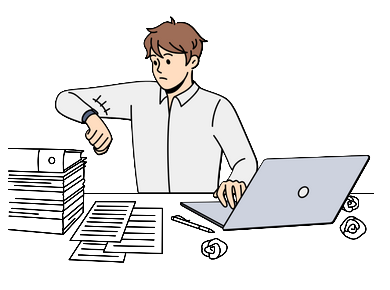The workplace is quickly shifting into a highly-digitized future, making work-from-home setups more common across industries. The COVID-19 pandemic fast-tracked this adoption by showing people that remote work isn’t just possible, it’s actually helpful too.
As a result, 81% of US employees say they prefer a hybrid or remote work setup even after the pandemic. With remote work now in the picture, managers and business owners face some challenges admittedly, but none that aren’t without solutions.
One of the common issues with remote work is the lack of accountability structures. Meaning, since people aren’t in the office, supervisors can’t just walk in to check on their work progress.
That’s where time tracking or time management solutions come in handy. But not all workers are open to the idea of employers tracking their hours.
To some, it feels like an invasion of their privacy. To others, it seems like micromanagement.
But are these always the case? And if not, how can we better communicate tracking solutions as a great way to move forward as digitized and flexible organizations?
Who Benefits from Time Tracking Software?
Only 18% of people have a time management system, and it leads to all sorts of problems like poor evaluation, lost productivity, and wage theft. Time tracking software can sometimes feel like the enemy to a virtual or hybrid team. Most of the time, this is the case because it’s not clear who gets to experience the benefits of time tracking.
Contrary to the common belief that only employers will be happy with time tracking software, both employers and employees can actually benefit when there is a time tracking and monitoring system in place. Here are the shared benefits that both parties win.
How Employers Benefit
- Avoid Time Theft — Time theft, or false records on time loggers to increase wages, cost companies a lot of money. With time trackers in place, managers can reduce or remove these unwanted losses.
- Automate HR Functions — Using time tracking tools side to side with the best payroll software solutions and other HR solutions can help automate human resource functions like team schedule management and payroll processing and disbursement.
- Provide Quantifiable Evaluations — Working hours aren’t always the only metric to team productivity, but it is asignificant basis. For instance, with time trackers, companies can see which teams actually produce in the time that they spend at work.
How Employees Benefit
- Avoid overwork — Time trackers aren’t only meant to track undertime. It’s also there to track overwork too. People who work more than 55 hours a week have a 35% higher risk of a stroke and a 17% higher risk of dying from heart disease. Work tracking is a way to watch out for staff who are at risk of burnout. That way, managers and supervisors can provide them with the necessary support and determine ways to avoid working over shift hours. Using an employee time clock app with GPS can help ensure that staff log their hours accurately and provide real-time data on their work patterns. This technology helps managers identify when employees are consistently exceeding their work hours and take steps to promote a healthier work-life balance.
- Stay productive — Using time management tools for employees will also become a benchmark for individual productivity. This means that staff should also use it to track where their time goes and find ways to stay more productive.
- Protect work boundaries — Work that we don’t get to complete within specified business hours will most likely spill into our personal time. With time trackers, staff members are able to create more clear boundaries about what time they should work and what time they should be off, creating more work-life bala
How to Implement Time Management and Tracking Software Without Losing Your Team’s Trust

Implementing time management tools and keeping your workforce motivated aren’t mutually exclusive from one another. To get both benefits, focus on how to introduce time tracking to employees. Here are some ways to introduce time tracking solutions without demotivating your team.
Explain the “why”
Sometimes, employees don’t see why their managers apply time tracking tools. And unless management provides a clear why, personnel will only feel more uncertainty and ambiguity towards monitoring tools. Allowing that to happen will most likely cause demotivation in teams.
But when leaders are transparent about what they would like to get out of the policy and what’s in it for employees too, you can clear the air and move forward as a team faster.
Set a company town hall before rolling out the system and explain your case. Be ready to listen to grievances of your employees and try to find a common ground if you can. Offer some level of compromise, such as giving one day in the week to take a “break” from tracking if there’s too much friction in the beginning.
Join the club
Implementing time tracking software for employees can create a rift between management and their subordinates. That divide will pull teams apart if kept unchecked.<[>So to bridge the gap, consider implementing time tracking software for supervisors and managers too. If a leader truly understands the advantages of using employee monitoring software, they shouldn’t have any problem being a part of the process too.
The principle of leadership by example is powerful for team building and culture cultivating. This applies in all aspects of the organization, including how we implement policies like time tracking solutions.
Make time tracking simple
For time tracking to become frictionless for an organization, it has to be simple enough to use. When time tracking software takes up considerable time and effort to do, it can cause unwanted strain. Moreover, it defeats the purpose of time tracking software, which is to make staff more productive.
Use time tracking and monitoring software with a simple user experience. When possible, integrate them with your communication tools. Slack, for instance, can integrate with a wide variety of time monitoring software so team members can simply clock in and out from there.
Focus on results
Another time management tip that makes for a successful time monitoring policy roll-out is to focus on results.
Don’t just track hours. Track output and results too.
For example, check the number of issues resolved by customer service staff or the overall sales brought in by sales representatives. Bounce off work hours with the work output that comes out of it.
Create a no-judgment zone
Sound time tracking best practices entails that you provide employees with the benefit of the doubt at all times. For example, you shouldn’t be quick to call out a worker for logging into Facebook during work hours given that they could probably be using it to contact clients or generate leads.
There’s no doubt that there will always be employees who take company policy for granted. But there will also be staff who are loyal to the company and policy. And to quickly dismiss someone for monitoring results could disregard the latter. Provide your team members with a no-judgment zone by giving them a chance to justify their performance or activities during work hours.
Incentivize time tracking
The last practice that can help soften a team’s heart towards time tracking software is to gamify it. Provide incentives to people who follow protocol. These incentives don’t have to be monetary or material in nature. Sometimes, even a simple word of honor can make all the difference.
Another great incentive idea is to include time tracking compliance to the criteria of the employee of the month award. You can also have groups work as a team and incentivize the teams who keep compliance perfectly to encourage collective accountability.
Trust and Accountability Builds Stronger Teams
Trust and accountability are not enemies when creating strong team cultures. In fact, they are both necessary. When we leverage both of them in our organizations, we can effectively maximize productivity without lowering team member morale.





